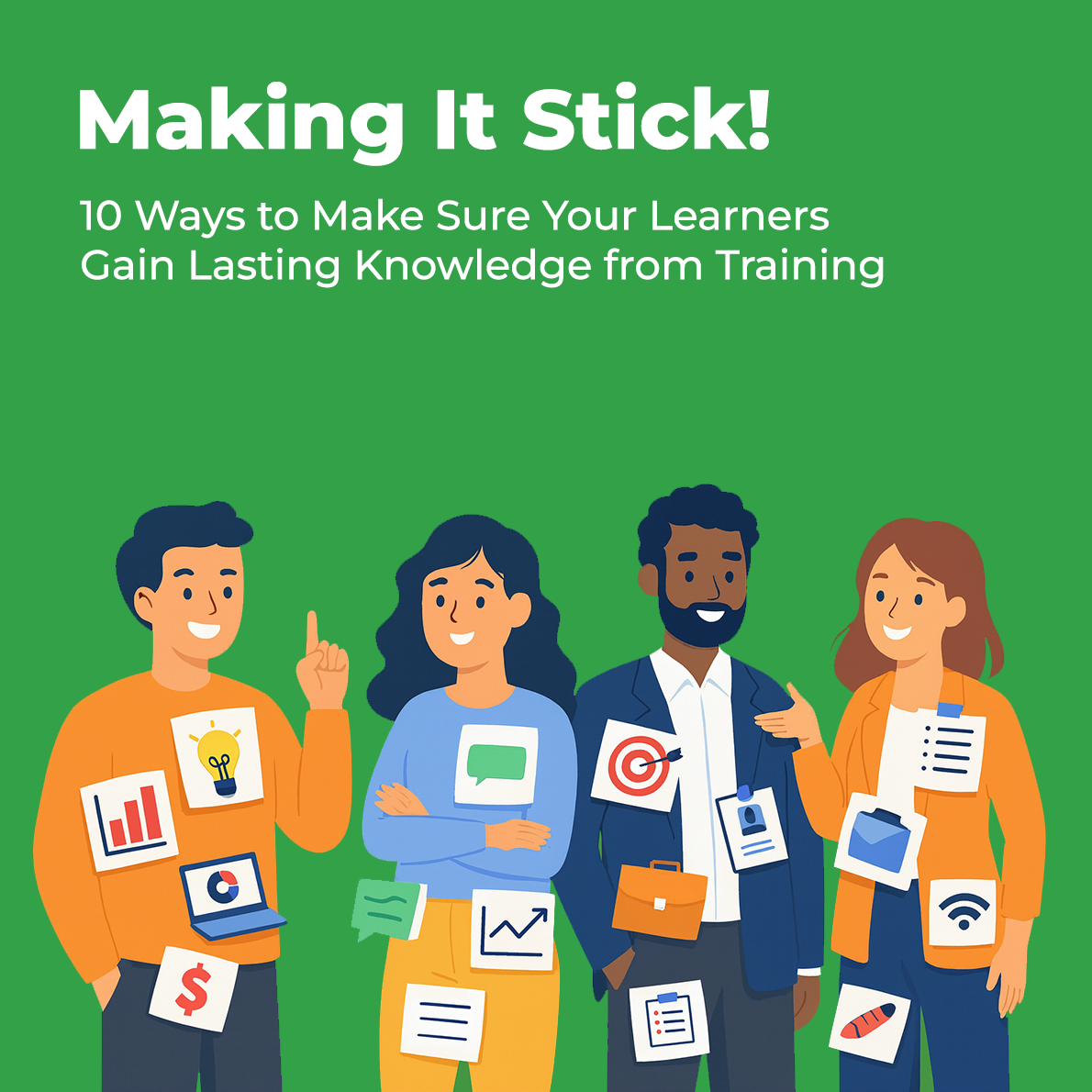10 Ways to Make Sure Your Learners Gain Lasting Knowledge from Training

Supporting employee performance is a foundational part of building a strong business, and it’s a significant investment. Consider that many companies spend around $1,200 per employee, per year, on skills development and learning, and it’s quickly apparent that L&D can both be a significant budget item.
The difference between viewing L&D as an investment rather than an expense comes down to your company’s ability to realize and measure the value of the learning, and to make sure the learning has impact: improvements in performance, capability, and efficiency that endures.
The discussion of value, then, is largely in two parts: the first part, achieving alignment between your learning outcomes and business objectives, is about whether the learning exercise is on target; the second part, making sure the outcomes of the learning experience are sustained over time, is what we’ll explore further.
If the first part is about hitting the right target, the second part is about making it stick. Let’s explore ten evidence-based approaches you can use to make learning stick (plus a “bonus” 11th approach).
The human brain struggles to retain large volumes of information learned all at once. For more than a century, researchers have documented the spacing effect: the finding that information is better remembered when learning sessions are spread out. In a 2006 meta-analysis, cognitive psychologist Nicholas Cepeda and colleagues synthesized data from 254 studies and confirmed that distributed learning leads to much stronger long-term retention than massed practice.
For senior L&D managers, this principle points to the importance of designing training as a sequence of touchpoints rather than one-time events. A compliance program, for example, should begin with a core session but also include strategically timed refreshers—perhaps a microlearning module after two days, a discussion prompt after a week, and a scenario-based challenge after a month.
This method can be particularly effective in environments with high regulatory or technical demands. Instead of relying on annual refreshers that fade quickly, organizations can distribute training across a quarter or year to reinforce retention and keep knowledge fresh.
For Example: A global pharmaceutical company shifted from a single-day compliance training to a series of shorter sessions with monthly digital “knowledge checks.” Managers reported improved retention and noted a reduction in audit-related errors, demonstrating the business value of spaced learning.
Memory researchers Henry Roediger and Andrew Butler found in a 2011 research analysis that retrieval practice not only strengthens recall but also improves the learner’s ability to apply learned knowledge to new situations.
In other words, quizzes or application exercises that require learners to actively remember new information will help the memory stick. This method is best used in a learning scenario that integrates low-stakes practice, as the effect diminishes in high-pressure situations. Quizzes added to the end of learning modules are a step toward creating retrieval practice, as are prompts for manager-led or team discussions where recall questions are provided. Asking “what would you do?” after outlining a scenario can also be a way to support learners’ retrieval of new material.
For L&D leaders, retrieval practice can be built into almost any program. It doesn’t require complicated technology: simple reflection questions, quick polls, or team-based “knowledge challenges” will suffice. The key is consistency.
For Example: After a leadership development workshop, managers receive weekly “scenario emails” asking how they would respond to realistic challenges. These exercises take less than five minutes each but have a measurable effect: participants score higher on follow-up assessments and showed stronger transfer of skills in performance reviews.
UCLA psychologist Robert Bjork introduced the concept of “desirable difficulties” as learning conditions that feel effortful but lead to stronger retention. His work showed that when learners must grapple with problems, such as identifying errors or solving challenges without immediate guidance, they build deeper understanding.
For L&D leaders, this means resisting the temptation to oversimplify. Real learning often involves productive struggle. Providing flawed examples, using interleaved practice, or assigning problem-based case studies all require learners to think harder, which leads to longer-lasting outcomes.
In your L&D practice, you can use desirable difficulties in areas that require problem-solving, leadership, or analytical skills. Calibrate the challenge so that it is achievable without discouraging learners.
For Example: In a customer service training program, employees review transcripts of poorly handled calls and are asked to identify the mistakes. They then re-script the conversations for improvement. The struggle to diagnose problems strengthens their grasp of effective communication strategies.
Deliberate practice, or the development of mastery from focused, goal-directed repetition with feedback, comes from the work of psychologist K. Anders Ericsson. His 1993 paper remains a foundational resource on the topic.
For corporate training, deliberate practice means designing opportunities for learners to repeat skills with clear criteria and targeted feedback. Instead of one-off role plays, create cycles of practice where learners improve each time.
In L&D practice, deliberate practice can be best suited for complex skills—sales, negotiations, coaching, technical troubleshooting—where the objective is to build confidence and precision.
For example: A software company might build iterative practice into its onboarding program for support engineers. New hires role-play customer calls repeatedly, with feedback after each attempt. In one example of this practice, customer issue resolution times were reduced by one-fifth within three months.
Learning is both a process that happens during and after the learner takes action. In his book “The Reflective Practitioner,” Donald Schon says the process of reflection enables the learner to connect theory to lived experience.
For L&D leaders, encouraging reflection ensures that training doesn’t stay abstract. Structured reflection might include journals, peer debriefs, or manager-led discussions.
This can be done by adding prompts such as: What did I try? What worked? What would I do differently? Reflection helps employees analyze and improve their performance.
For example: After conflict resolution training, ask managers to reflect on their next employee mediation and share lessons during peer meetings. This practice can both deepen individual learning and also support the development of organizational knowledge.
Making sure the learning experience is realistic is a building block of a successful outcome. In “The Adult Learner,” adult learning pioneer Malcolm Knowles emphasized that adults learn best when content is relevant, problem-centered, and immediately applicable.
For L&D leaders, this means embedding learning in authentic workplace contexts. Scenarios, case studies, and role plays based on actual business challenges increase engagement and transfer. Ground scenarios in organizational reality. Use anonymized company data or realistic role-play scripts.
For example: In a financial training, managers can practice budgeting using anonymized company data, ensuring their learning experience is immediately relevant to their roles.
It may seem like saying the obvious out loud, but the workplace environment has a profound effect on workplace learning. In other words, learning cannot only happen in the classroom. In the work of professors Timothy Baldwin and Kevin Ford, they found that job aids —tactical checklists, guides and templates — are an effective way to bridge this gap.
For L&D leaders, job aids are cost-effective tools for reinforcing training at the point of need. Provide simple, accessible job aids alongside programs and normalize their use by embedding them in workflows.
For example: After feedback training, managers use a one-page checklist during employee conversations. When done consistently, this approach can result in measurably improved employee feedback.
Programs that are directly linked to performance outcomes deliver a higher transfer of learning. Put simply, learning happens more effectively when it is clear to the learner how the material relates to their workplace and their specific job.
This is supported by the research of Ohio State professor Philomina Abena Anyidoho and colleagues, whose work suggests better results can be achieved by aligning training objectives with organizational metrics. Defining measurable outcomes upfront enables clear ROI assessment. One way to begin is by setting SMART goals in collaboration with business leaders, and being sure to evaluate and share outcomes post-training.
For example: After a time management program, the trained team sets a goal of reducing missed deadlines by 15%. Establishing and tracking this single metric provides tangible evidence of training impact without being administratively burdensome.
In a high-stakes or otherwise stressful environment, learner performance improves when the learners continue to practice even after achieving initial mastery. This can be an important element for safety-critical roles. Overlearning (continuing practice beyond initial mastery) is especially important in high-stakes contexts. In a 1992 research review, professor John Driskell and colleagues set out that overlearning does increase information recall, but the effect may be mitigated somewhat by the type of task and the length of time learners are expected to retain the information.
In practice, you can identify mission-critical tasks and require practice beyond mastery, with structures in place to assess information retention over time (see “Approach #1” above).
For example: Hospital staff rehearse emergency code procedures until responses are automatic. This supports performance during a real emergency, where protocol must be executed flawlessly.
People learn by observing and teaching others. This is a frequent and important aspect of organizational learning and development programs, where it’s often referred to as the “70” or largest percentage of the 70-20-10 model.
The importance of social learning was explored by the work of psychologist Albert Bandura, whose social learning theory emphasizes the importance of imitation, modeling, and reinforcement in the learning process. Peer teaching requires learners to organize and articulate their knowledge, deepening retention. For L&D leaders, peer learning also fosters a culture of collaboration and accountability, which can be in the form of learner teach-backs, learner-led discussions, or mentoring conversations.
For example: After a project management training, learners lead 10-minute sessions on risk analysis and stakeholder management. These teaching events (like a “lunch and learn”) reinforce their knowledge and help share information through the organization.
Simulations and hands-on learning enhance information integration and retention, and can be enhanced by technologies like augmented reality or virtual reality. Research has shown how skill acquisition in industrial settings was improved measurably by creating realistic, low-risk practice environments.
The value of VR/AR and simulations to learnings is clear in technical or safety-critical tasks, where errors are costly. And while emerging technologies continue to be increasingly accessible, simulations can be effective without spending on the tech. Live simulations or desktop simulation exercises can be effectively executed, even if you entirely eschew technologies in favor of index cards and sticky notes. A key is to let the technology enable the learning experience, rather than crafting the learning experience around the technology.
For example: You may pilot AR for onboarding in specific high-stakes roles, or VR to create a “de-risked” environment for the practice of difficult conversations or other leader development tasks.
Delivering learning that sticks requires instructional design choices grounded in research: spacing content, requiring retrieval, encouraging reflection, creating challenge, and reinforcing with tools and goals. It also requires a willingness to leverage new approaches, from peer teaching to immersive technology.
For senior L&D leaders, the message is clear: investing in training design based on evidence pays dividends in performance, capability, and efficiency. By applying these ten (plus one) proven approaches, you can take steps to make sure your learning programs have real, durable and measurable impact on your organization, its people, and its performance.
Our team would be glad to speak with you about how to infuse these practices into your learning programs. Click here to contact us and schedule a call with our experts.
